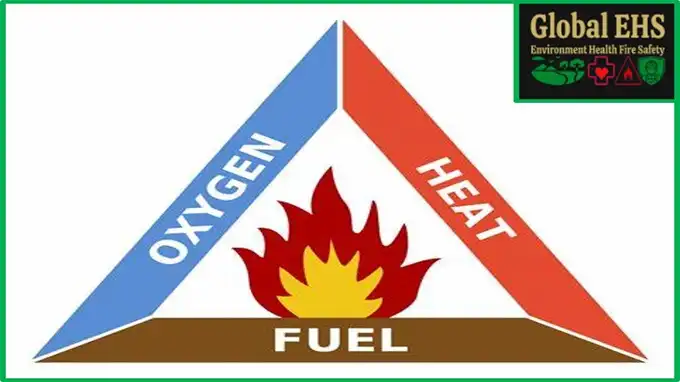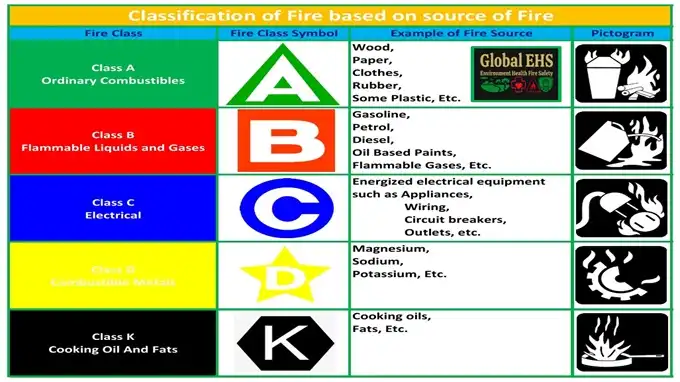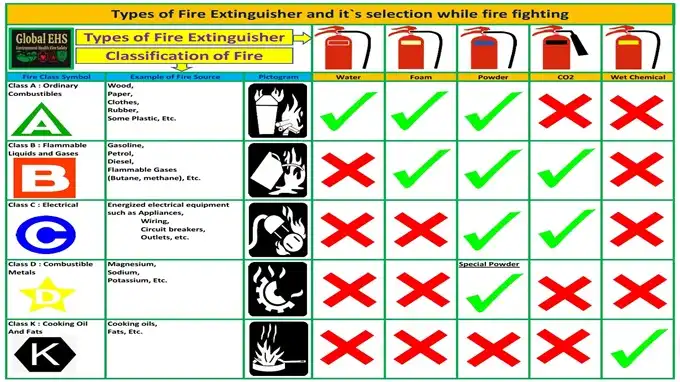It is crucial to understand definition, components and behavior of Fire for effective fire prevention, fire extinguishers requirements, firefighting and safety measures.
Definition of Fire:
Fire is a chemical reaction that causes rapid oxidation, releasing heat, light, and various reactants. This process, known as combustion, typically occurs in the presence of three components: a fuel source, an oxidizing agent (usually oxygen from the air), and an ignition source (heat).
The main components of fire are:
- Fuel: Any combustible material, such as wood, paper, gasoline, or natural gas, that can sustain a fire.
- Oxygen: Oxygen in the air in general and Other oxidizing agents.
- Heat: Enough heat to start and continue the combustion process. Heat from various sources, including friction, electrical sparks, chemical reactions, or open flames.
The Fire Triangle:
- Fuel
- Oxygen
- Heat

All three elements must be present and maintained for a fire to ignite and burn consistently. The fire can be extinguished by removing any of these items. This concept is often represented by a “Fire Triangle”.
Fire Tetrahedron:
- Fuel
- Oxygen
- Heat
- Chemical Chain Reaction

The fire tetrahedron expands on the fire triangle by adding the chemical chain reaction necessary to sustain combustion. Interrupting this chain reaction can also extinguish the fire.
Phases of Fire:
- Ignition: The initial stage where fuel, oxygen, and heat combine to start the fire.
- Growth: The fire spreads and grows in intensity as it consumes more fuel and produces more heat.
- Fully Developed: The fire reaches its peak intensity, consuming the available fuel at its maximum rate.
- Decay: The fire’s intensity decreases as the fuel is consumed and heat is reduced.
Types of Combustion:
- Complete Combustion: Occurs when there is enough oxygen for the fuel to react completely, producing carbon dioxide, water, and releasing maximum heat.
- Incomplete Combustion: Occurs when there is insufficient oxygen, resulting in the production of carbon monoxide, soot, and less heat.
By-products of Fire:
- Heat: The primary output of fire, which can cause burns and increase the spread of fire.
- Light: Visible flames and glow from the combustion process.
- Smoke: A mixture of airborne solid and liquid particulates, gases, and aerosols produced during combustion.
- Gases: Carbon dioxide (CO₂), carbon monoxide (CO), water vapor (H₂O), & other toxic gases depending on the materials burned.
Classification of Fire:
As per NFPA, based on source of material for fire, they are classified in to A, B, C, D, K.

1. Class A: Ordinary Combustibles
- Description: For fires involving common combustible materials such as wood, paper, cloth, rubber, and some plastics.
- Extinguishing Agents: Water, foam, multipurpose dry chemical.
- Symbol: Green triangle with an “A”.
2. Class B: Flammable Liquids and Gases
- Description: For fires involving flammable or combustible liquids and gases like gasoline, oil, grease, tar, oil-based paints, and flammable gases.
- Extinguishing Agents: Carbon dioxide (CO₂), foam, dry chemical.
- Symbol: Red square with a “B”.
3. Class C: Electrical Equipment
- Description: For fires involving energized electrical equipment such as appliances, wiring, circuit breakers, and outlets.
- Extinguishing Agents: Non-conductive agents like carbon dioxide (CO₂), dry chemical.
- Symbol: Blue circle with a “C”.
4. Class D: Combustible Metals
- Description: For fires involving combustible metals such as magnesium, titanium, potassium, and sodium.
- Extinguishing Agents: Dry powder specifically designed for the particular metal.
- Symbol: Yellow star with a “D”.
5. Class K: Cooking Oils and Fats
- Description: For fires involving cooking oils and fats, common in commercial kitchens.
- Extinguishing Agents: Wet chemical agents designed to saponify oils and fats, forming a non-combustible soapy layer.
- Symbol: Black hexagon with a “K”.
Note:
- Fires where the fuel is flammable or combustible gas are classified as “Class C” in the European/Australian system, and “Class B” along with flammable liquids in the US system.
- Electrical Fires are classified as a “Class E” fire under the Australian system, “Class C” under the American system.
- Fires involving cooking oils and fats are classified as “Class F” under the European and Australian systems, and “Class K” under the American system.
It is necessary to understand the components, types, operation and maintenance of fire extinguishers, so that individuals can be ready to handle fire emergencies effectively.
Definition of Fire Extinguisher:
A fire extinguisher is a portable device designed to extinguish or contain small fires in an emergency. This is usually a pressurized vessel with a deployable fire extinguishing media to prevent flames. Fire extinguishers are an integral part of fire protection equipment and are commonly available in residential, commercial, industrial and public buildings.
Key Components:
- Container: The body of the fire extinguisher, usually made of metal, that holds the extinguishing agent under pressure.
- Extinguishing Agent: The substance used to put out the fire. Common agents include water, foam, dry chemical powder, carbon dioxide (CO₂), and wet chemicals.
- Pressure Mechanism: A system that pressurizes the extinguishing agent to enable its discharge. This typically involves a compressed gas (such as nitrogen) or a manually operated pump.
- Hose and Nozzle: A flexible tube (hose) and a directing nozzle that allow the user to aim and control the discharge of the extinguishing agent.
- Handle and Trigger: The handle is used to carry the extinguisher, and the trigger or lever is used to activate the discharge mechanism.
- Pressure Gauge: Indicates whether the extinguisher is properly pressurized and ready for use.
- Safety Pin and Seal: Prevents accidental discharge. The pin must be removed to activate the extinguisher, and a tamper-evident seal ensures it hasn’t been used or tampered with.
Operation of Fire Extinguisher:
Remember PASS acronym for the typical operation of a fire extinguisher:
- Pull the safety pin.
- Aim the nozzle or hose at the base of the fire.
- Squeeze the handle or trigger to release the extinguishing agent.
- Sweep the nozzle from side to side at the base of the fire until it is extinguished.
Maintenance of Fire Extinguisher:
- Regular fire extinguisher inspections are necessary to ensure that they are working properly.
- The pressure gauge should be checked to ensure that the fire extinguisher is fully charged.
- Professional maintenance and service should be performed annually or as recommended by the manufacturer.
Different types of Fire Extinguishers (Based on extinguishing media):
There are some common types as given below;

1. Water (Class A):
- Identification: Red Neckband
- Use: Effective on fires involving ordinary combustibles such as wood, paper, cloth, and some plastics.
- Not Suitable For: Fires involving flammable liquids, electrical equipment, or metals.
- Label: Green triangle with an “A”.
2. Foam (Class A and B):
- Identification: Cream (Lemon Yellow) Neckband
- Use: Suitable for fires involving flammable liquids (Class B) as well as ordinary combustibles (Class A).
- Not Suitable For: Electrical fires (unless specified as safe) or metal fires.
- Label: Green triangle with an “A” and Red Square with a “B”.
3. Dry Powder (Class A, B, C, and D):
- Identification: Blue Neckband
- Use: Versatile; can be used on fires involving ordinary combustibles, flammable liquids, flammable gases, and combustible metals.
- Class D: Special powders are designed for metal fires.
- Label: Green triangle with an “A” and Red Square with a “B” and Yellow Star with a “D”.
4. Carbon Dioxide (Class B and C):
- Identification: Black Neckband
- Use: Effective on fires involving flammable liquids (Class B) and electrical fires (Class C).
- Not Suitable For: Ordinary combustibles and metal fires.
- Label: Red Square with a “B” and Blue Circle with a “C”.
5. Wet Chemical (Class K):
- Identification: Yellow Neckband
- Use: Specifically designed for fires involving cooking oils and fats (Class K).
- Not Suitable For: Most other types of fires.
- Label: Black hexagon with an “K”.
6. Clean Agent (Class B and C):
- Identification: Green Neckband
- Use: Effective on flammable liquid fires (Class B) and electrical fires (Class C). Clean agents do not leave residue, making them suitable for protecting sensitive equipment.
- Label: Red Square with a “B” and Blue Circle with a “C”.
Applications of Fire Extinguisher:
The need of Fire extinguishers are at:
- Homes: To quickly deal with kitchen fires, electrical fires, or minor incidents before they spread.
- Workplace: Safety regulations require employees to ensure that they can respond to fire.
- Public housing: For the safety of residents in an emergency.
- Vehicles: Especially in commercial and industrial areas where flammable materials may be present.
Available weights of fire extinguishers in the market:
- Different weights available in market depending on the manufacturer, Like : 1, 2, 3, 6, 9, 12, 18 kg, etc.
- Commonly 6 kg weight Fire Extinguisher are used in major premises for the benefit of easy carriage and movement.
- For specific locations like gas stations, near solvent yard, near panel room weight up to 45 kg are used for manual extinguisher and moved using wheels or trolleys.
Fire Extinguisher Placement:
The distribution of manual fire extinguishers within a building is governed by various safety codes and standards to ensure effective and accessible fire protection. Here are the key considerations and guidelines for distributing fire extinguishers within a building:
Key Considerations for Fire Extinguisher Placement:
- Types of Hazards: Identify the types of fire hazards present in different areas of the building. This determines the type and rating of fire extinguishers needed (e.g., Class A for ordinary combustibles, Class B for flammable liquids, Class C for electrical equipment).
- Accessibility: Fire extinguishers must be easily accessible in case of an emergency. Install it in visible locations, along normal paths of travel, and near exits.
- Travel Distance: The maximum travel distance to reach a fire extinguisher is specified by fire codes. Refer applicable rules and regulation (For e.g. NFPA 10) and implement it.
- Mounting and Visibility: Mount Fire extinguishers on brackets, in cabinets, or on wall hooks, typically 3.5 to 5 feet above the floor for easy access. Display signage to indicate the location of fire extinguishers, especially if they are not immediately visible.
- Special Hazard Areas: Areas with specific fire hazards (e.g., kitchens, laboratories, mechanical rooms) may require additional or specialized fire extinguishers (e.g., Class K for kitchens).



Leave a Comment